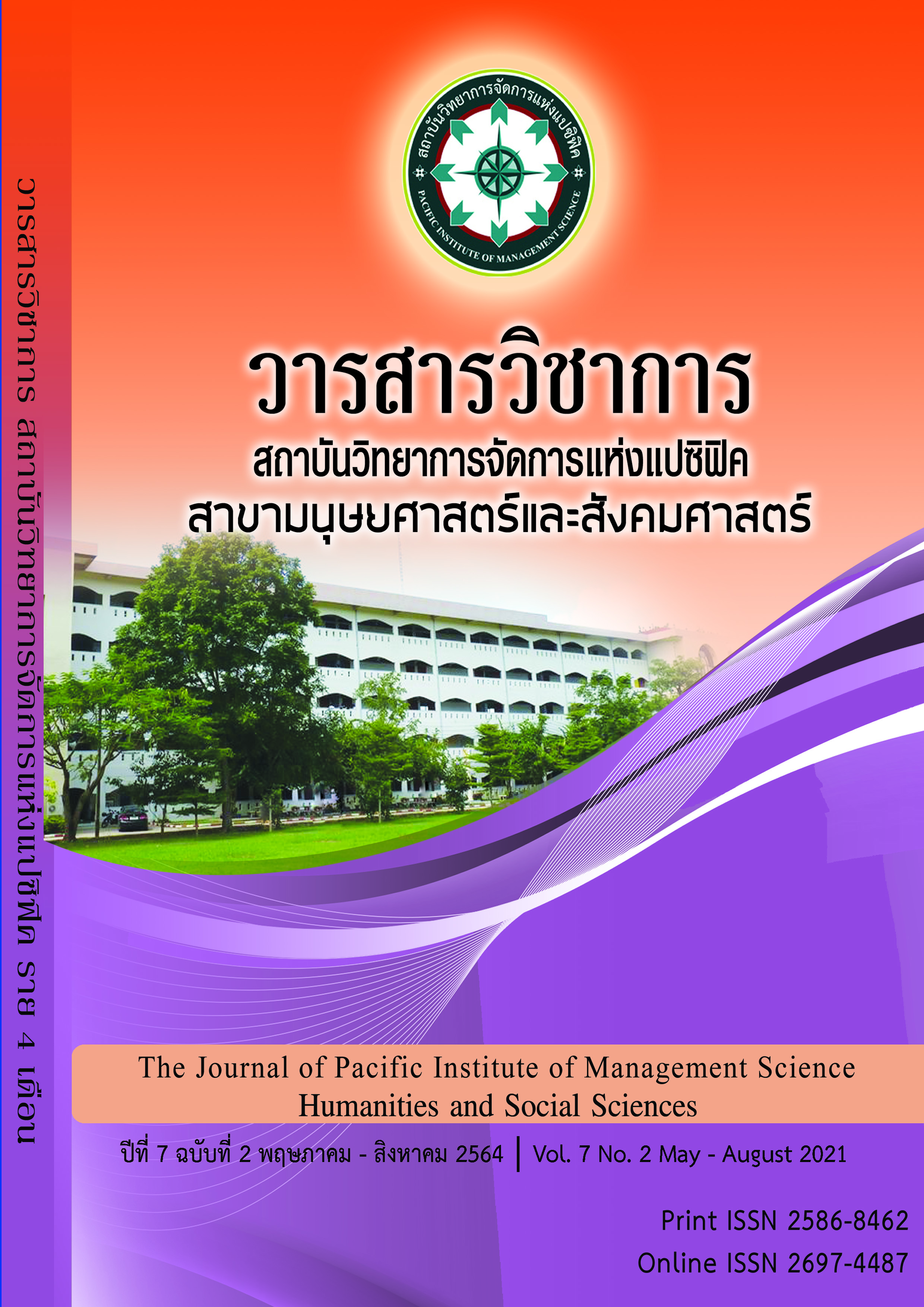Measure of Labour Right Protection in the Surat Thani Province
Keywords:
Labour Protection Act, Wage Management, Wage.Abstract
The objective of this research is 1) study the root cause of the problem of labour right protection about wage which is the working condition of businesses in Surat Thani province and 2) seek a labour protection measure about the wage to solve the problem of violation of labour fundamental rights in Surat Thani province. The research employed the qualitative research method, in-depth interview and focus group.
The study found that 1) the cause of the problem of labour right protection about wage which is the working condition of businesses in Surat Thani province was a business failed to apply the wage regulation to ensure an employer pays wage to an employee legally according to the objective of compensation for working rather than paying the wage to influence an employee to work exceeding an expected standard such as working diligently and paying incentive fee. These payments were not a normal wage but compensation in form of welfare. 2) Regarding the measure of labour right protection about the wage to solve the problem of fundamental rights violation of labour in Surat Thani province, the Department of Labour Protection and Welfare (DLPW) introduced a measure for labour protection management concerning the inspection of businesses having 10 employees or over about working condition and condition of working place for each fiscal year by virtue of Labour Protection Act B.E. 2541 (1998) amended by Labour Protection Act (2nd edition) B.E. 2551 (2008) Section 115/1 which stipulated that an employer who employed 10 employees or over shall submit the form displaying working condition and condition of working place to director-general or those assigned by director-general within January of every year. In case any business or employer violated or failed to submit the form displaying working condition and condition of working place (Form Khor Ror. 11) within the required period. The act on labour protection stipulated the criminal punishment of a fine not exceeding 20,000 Baht. In case the business or employer provided a false statement, he/she must be imprisoned for not more than six months or fined not over one thousand baht or both according to Section 137 of the Criminal Code. Regarding the law enforcement issues, it was found that there were still issues to be reviewed or improved in terms of efficiency and effectiveness. In terms of quantitative aspect, there were still a number of violations of labour right in terms of wage which is the working condition of businesses in Surat Thani province which still occurs continuously, even the law stipulates the right protection and criminal punishment. In the enforcement of qualitative aspect, there were still problems and restrictions in terms of manpower and capabilities of government which could not operate in certain areas.
The author puts forward the suggestion as follows: 1) relevant government agencies should have clear regulations or rules based on objectivity and not depending on discretion only for suggestion and compromise in the same direction. At least, the bottom line should be stipulated according to rules or elements of wage according to the judgement given by the Supreme Court as a guideline as the employee has lower social status and financial position. 2) Regarding the labour protection about wage, the author suggests that the labour protection manual on direct management of wage based on regulations laid down by the Supreme Court, Labour Case. According to Supreme Court N0. 857/2544 which stipulated 3 elements: 1st element, the name of wage, how to pay and how to define or calculate shall be ignored, 2nd element, the employer shall pay a wage to the employee only, not via other person and 3rd element, the employer shall pay wage for compensating the working during the normal working day as the employer stipulates subject to the law.
References
กระทรวงแรงงาน, กรมสวัสดิการและคุ้มครองแรงงาน. (2563). รายงานจำนวนสถานประกอบกิจการจำแนกตามภาคใต้ เขตรับผิดชอบจังหวัดสุราษฎร์ธานี. กรุงเทพมหานคร : กองคุ้มครองแรงงาน กรมสวัสดิการและคุ้มครองแรงงาน.
กระทรวงแรงงาน. (ลงวันที่ 22 กันยายน 2563). นโยบายรัฐมนตรีว่าการกระทรวงแรงงาน ปี 2563. ให้แก่หัวหน้าส่วนราชการสังกัดกระทรวงแรงงานทั้งส่วนกลางและส่วนภูมิภาคประจำปี 2563.
กรมสวัสดิการและคุ้มครองแรงงาน. คู่มือปฏิบัติงานด้านคุ้มครองแรงงาน (ประจำปีงบประมาณ พ.ศ. 2563)
กรมสวัสดิการและคุ้มครองแรงงาน, กองนิติการ. “คำชี้แจงกระทรวงแรงงาน เรื่อง พระราชบัญญัติคุ้มครองแรงงาน (ฉบับที่ 6) พ.ศ.2560” [Online], Available URL: http://legal.labour.go.th/2018/images/law/Protection2541/7/p_006.pdf เข้าถึงข้อมูลวันที่ 10 ตุลาคม 2562.
กองนิติการ, กรมสวัสดิการและคุ้มครองแรงงาน. (2544). คู่มือการดำเนินคดีอาญาตาม พระราชบัญญัติคุ้มครองแรงงานพ.ศ. 2541.กรุงเทพมหานคร : บพิธการพิมพ์.
เกษมสันต์ วิลาวรรณ. (2553). การเลิกจ้างและการลาออก. พิมพ์ครั้งที่ 8. กรุงเทพมหานคร : สำนักพิมพ์วิญญูชน.
เกษมสันต์ วิลาวรรณ. (2556). คำอธิบายกฎหมายแรงงาน. พิมพ์ครั้งที่ 20. กรุงเทพมหานคร : สำนักพิมพ์วิญญูชน.
จาตุรนต์ แก่นศึกษา. (2542). การใช้แรงงานทั่วไปตามพระราชบัญญัติคุ้มครองแรงงาน พ.ศ. 2541 : ศึกษาเปรียบเทียบกับอนุสัญญาและข้อเสนอแนะขององค์การแรงงานระหว่างประเทศ. “งานนิพนธ์” วิทยานิพนธ์นิติศาสตรมหาบัณฑิต : มหาวิทยาลัยธุรกิจบัณฑิต, ถ่ายเอกสาร.
จำรัส เขมะจารุ. (2527). ศาลแรงงานและวิธีพิจารณาคดีแรงงาน. พิมพ์ครั้งที่ 3. กรุงเทพมหานคร : โรงพิมพ์ รุ่งเรืองธรรม
บูรณ์ ฐาปนดุลย์. (2553). ขั้นตอนและวิธีการก่อนนำคดีมาสู่ศาลตามพระราชบัญญัติคุ้มครองแรงงาน พ.ศ. 2541. “งานเอกสาร” ผู้บริหารกระบวนการยุติธรรมระดับสูง (บ.ย.ส.) : วิทยาลัยการยุติธรรม. สำนักงานศาลยุติธรรม, ถ่ายเอกสาร.
นพดล ทัดระเบียบ. (2551). ปัญหาการดำเนินคดีอาญาในความรับผิดตามพระราชบัญญัติ คุ้มครองแรงงาน พ.ศ.2541 แก้ไขเพิ่มเติม (ฉบับที่ 2) พ.ศ. 2551. วิทยานิพนธ์ปริญญานิติศาสตรมหาบัณฑิต, คณะนิติศาสตร์ มหาวิทยาลัยรามคำแหง.
พงรัตน์ เครือกลิ่น. (2555). คำอธิบายกฎหมายแรงงานเพื่อการบริหารทรัพยากรมนุษย์. พิมพ์ครั้งที่ 8. กรุงเทพมหานคร : สำนักพิมพ์นิติธรรม.
พิพัฒน์ ปรีดาวิภาต. (2549). อุทธรณ์ข้อเท็จจริงในกฎหมายแรงงาน. “งานเอกสาร” ผู้บริหารกระบวนการยุติธรรมระดับสูง (บ.ย.ส.) : วิทยาลัยการยุติธรรม. สำนักงานศาลยุติธรรม, ถ่ายเอกสาร.
รัฐธรรมนูญแห่งราชอาณาจักรไทย. (2560,6 เมษายน). ราชกิจจานุเบกษา. เล่ม 134 /ตอนที่ 40 ก/หน้า 1
สวัสดิการและคุ้มครองแรงงาน, กรม. (2560). รายงานความเคลื่อนไหวด้านเศรษฐกิจ-แรงงาน. กรุงเทพมหานคร : สำนักพัฒนามาตรฐานแรงงาน กรมสวัสดิการและคุ้มครองแรงงาน.
สวัสดิการและคุ้มครองแรงงาน, กรม. (2563). ข้อมูลสำคัญผู้บริหาร. กรุงเทพมหานคร : สำนักงานเลขานุการกรม กรมสวัสดิการและคุ้มครองแรงงาน.
สวัสดิการและคุ้มครองแรงงาน, กรม. (2555-2558). แผนปฏิบัติราชการ 4 ปี. กรุงเทพมหานคร : สำนักพัฒนามาตรฐานแรงงาน กรมสวัสดิการและคุ้มครองแรงงาน.
สำนักงานคณะกรรมการเศรษฐกิจและสังคมแห่งชาติ. (2557, 14 มกราคม). แผนพัฒนาเศรษฐกิจและสังคมแห่งชาติ ฉบับที่ 11 (พ.ศ. 2555-2559). (ออนไลน์). เข้าถึงได้จาก : http://www.nesdb.go.th/Default.aspx?tabid=139.
สุดาศิริ วศวงศ์. (2553). คำอธิบายเกี่ยวกับกฎหมายแรงงานสัมพันธ์ พิมพ์ครั้งที่ 8. กรุงเทพมหานคร: สำนักพิมพ์นิติบรรณการ.
อนุสัญญาเกี่ยวกับค่าตอบแทนที่เท่าเทียบกัน พ.ศ. 2494. (2557, 9 กรกฎาคม). (ออนไลน์). เข้าถึงได้จาก : http://ils.labour.go.th/doc/c100.pdf.
อัตราค่าแรงขั้นต่ำนานาชาติ 2011. (2557 17 มิถุนายน). (ออนไลน์). เข้าถึงได้จาก : http://www.minimum-wage.org/international/th/Francce.
Erickson, C. & Mitchell, D. (2000). Labor Standards and International Trade: Background and Analysis. “The Multilateral Trading System in a Globalizing World”. Edited by Lee-Jay Cho and Yoon Hyung Kim.Seoul: Korea Development Institute. June: pp. 275-315.
Heintz, J. (2002). Global Labor Standards: Their Impact and Implementation. “Working
International Labour Organization. (1991). International Labour Convention and Recommendations 1919-1981. Geneva: International Labour Office.
Mah, J. S. (1997). Core Labour Standards and Export Performance in Developing Countries. World Economy. Vol. 20 (6) (September). Pp. 773-785.
Downloads
Published
Issue
Section
License
บทความที่ได้รับการตีพิมพ์เป็นลิขสิทธิ์ของ สถาบันวิทยาการจัดการแห่งแปซิฟิค
ข้อความที่ปรากฏในบทความแต่ละเรื่องในวารสารวิชาการเล่มนี้เป็นความคิดเห็นส่วนตัวของผู้เขียนแต่ละท่านไม่เกี่ยวข้องกับสถาบันวิทยาการจัดการแห่งแปซิฟิค และคณาจารย์ท่านอื่นๆในสถาบันฯ แต่อย่างใด ความรับผิดชอบองค์ประกอบทั้งหมดของบทความแต่ละเรื่องเป็นของผู้เขียนแต่ละท่าน หากมีความผิดพลาดใดๆ ผู้เขียนแต่ละท่านจะรับผิดชอบบทความของตนเองแต่ผู้เดียว







